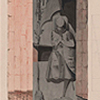Willem II of Floris de Voogd? Vragen rond een grafmonument en een skelet in de Koorkerk te Middelburg
DOI:
https://doi.org/10.18352/bmgn-lchr.10144Keywords:
History, archeology, Holy Roman Empire, tombAbstract
William II or Florence the Guardian?: Questions about a Tomb and a Skeleton in the Abbey Church at Middelburg
Both William II, Count of Holland and Zeeland and King of the Holy Roman Empire (†1256, re-interred 1282) and his brother Florence the Guardian (†1258) are buried in the Norbertine abbey church in Middelburg. In 1817 a skeleton was found in a bricked up niche, along with the remains of a tombstone on which was carved a knightly figure whose shield bears the coat of arms of Holland.
Based on the results of an examination of the bones by George J.R. Maat and his team (Leiden University Medical Centre), Henderikx takes it that the skeleton could be either that of the King of the Holy Roman Empire or of Florence the Guardian. Considering that the skeleton, burial space and tombstone formed a coherent whole, and the high-relief on the tombstone almost certainly does not refer to the King of Rome but to his brother, Henderikx concludes that the skeleton must be the earthly remains of Florence the Guardian.
This article is part of the discussion forum 'At the Meeting Point of Historical Disciplines'.
Roomskoning Willem II, graaf van Holland en Zeeland (†1256, herbegraven 1282) en diens broer Floris de Voogd (†1258) zijn beiden in de norbertijner abdijkerk in Middelburg begraven. In 1817 werd daar in een dichtgemetselde nis een skelet aangetroffen samen met de resten van een zerk met daarop een gebeeldhouwde ridderfiguur met op diens wapenschild het wapen van Holland.
Uitgaande van de resultaten van het onderzoek van het botmateriaal door George J.R. Maat cum suis (Leids Universitair Medisch Centrum) stelt Henderikx vast dat het skelet afkomstig kan zijn van zowel de Roomskoning als van Floris de Voogd. Aangezien skelet, grafruimte en zerk steeds één samenhangend geheel hebben gevormd en het beeldhouwwerk op de zerk zo goed als zeker niet naar de Roomskoning maar naar diens broer verwijst, komt Henderikx tot de conclusie dat het skelet het stoffelijk overschot moet zijn van Floris de Voogd.
Dit artikel maakt deel uit van het discussiedossier 'Op het raakvlak van historische disciplines'.
Downloads

Published
Issue
Section
License
Authors who publish with this journal agree to the following terms:
a) Authors retain copyright and grant the journal right of first publication with the work simultaneously licensed under a Creative Commons Attribution 4.0 International (CC BY 4.0) that allows others to share the work with an acknowledgement of the work's authorship and initial publication in this journal.
b) Authors are able to enter into separate, additional contractual arrangements for the non-exclusive distribution of the journal's published version of the work (e.g., post it to an institutional repository or publish it in a book), with an acknowledgement of its initial publication in this journal.
c) Authors are permitted to post their work online (e.g., in institutional repositories or on their website) prior to and during the submission process.
Authors are explicitly encouraged to deposit their published article in their institutional repository.







